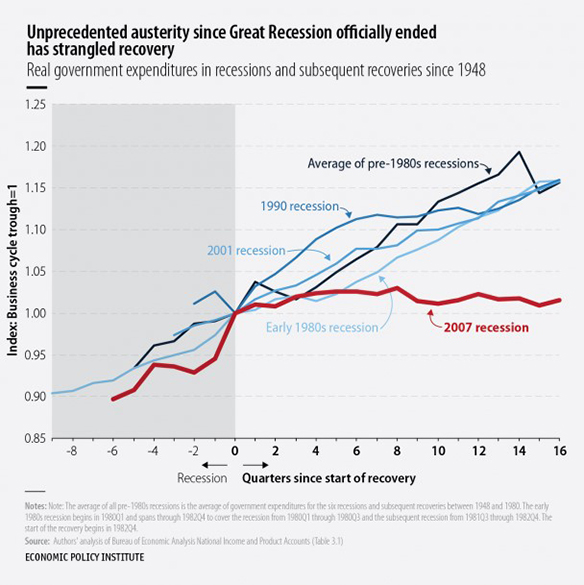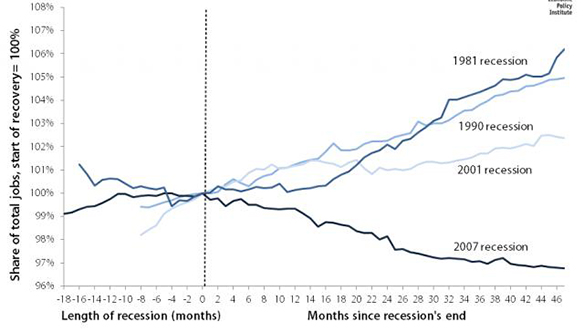The current economic recovery officially began in June 2009 and is one of the weakest in the post-World War II period. This is true by almost every indicator, except growth in profits.
One reason it has offered working people so little is the contraction of government spending and employment. This may sound strange given the steady drumbeat of articles and speeches demanding a further retrenchment of government involvement in the economy, but the fact is that this drumbeat is masking the reality of the situation.
This figure shows the growth in real spending by federal, state, and local governments in the years before and after recessions. The black line shows the average change in public spending over the six business cycles between 1948 and 1980. Each blue line shows government spending for a different recent business cycle and the red line does the same for our current cycle. As you can see, this expansionary period stands out for having the slowest growth in public spending. In fact, in contrast to other recovery periods, public spending is actually declining.

According to Josh Bivens:
…public spending following the Great Recession is the slowest on record, and as of the second quarter of 2013 stood roughly 15 percent below what it would have been had it simply matched historical averages … if public spending since 2009 had matched typical business cycles, this spending would be roughly $550 billion higher today, and more than 5 million additional people would have jobs (and most of these would be in the private sector).
The basic stagnation in government spending has actually translated into a significant contraction in public employment. This figure highlights just how serious the trend is by comparing public sector job growth in the current recovery to the three prior recovery periods.

As Bivens and Heidi Shierholz explain:
…the public sector has shed 737,000 jobs since June 2009. However, this raw job-loss figure radically understates the drag of public-sector employment relative to how this sector has normally performed during economic recoveries…. [P]ublic-sector employment should naturally grow as the overall population grows. Between 1989 and 2007, for example, the ratio of public employment to overall population was remarkably stable at roughly 7.3 public sector workers for each 100 members of the population. Today’s ratio is 6.9, and if it stood at the historic average of 7.3 instead, we would have 1.3 million more public sector jobs today.
In short, the challenge we face is not deciding between alternative ways to further shrink the public sector but rather of designing and building support for well financed public programs to restructure our economy and generate living wage jobs.
This post originally appeared onSociological Images, a Pacific Standard partner site.




